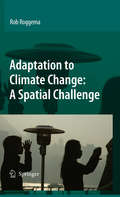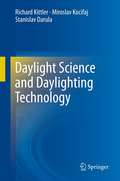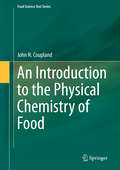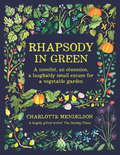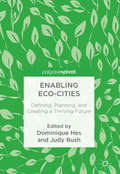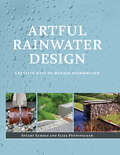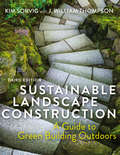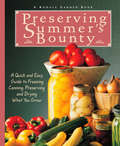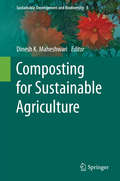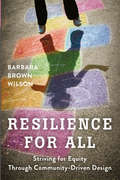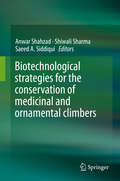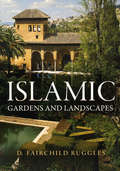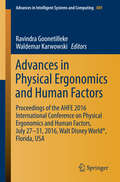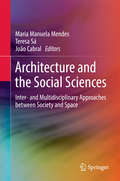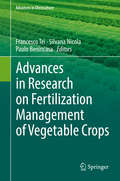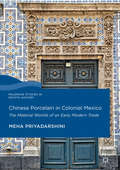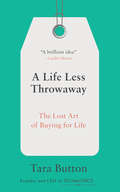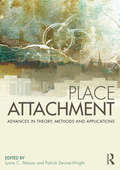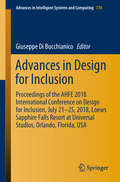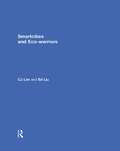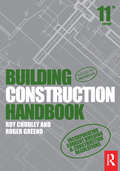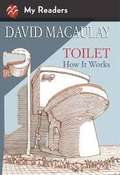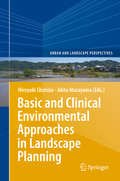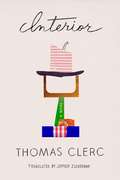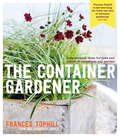- Table View
- List View
Adaptation to Climate Change: A Spatial Challenge
by Rob RoggemaAs it becomes clear that climate change is not easily within the boundaries of the 1990's, society needs to be prepared and needs to anticipate future changes due to the uncertain changes in climate. So far, extensive research has been carried out on several issues including the coastal defence or shifting ecozones. However, the role spatial design and planning can play in adapting to climate change has not yet been focused on. This book illuminates the way adaptation to climate change is tackled in water management, ecology, coastal defence, the urban environment and energy. The question posed is how each sector can anticipate climate change by creating spatial designs and plans. The main message of this book is that spatial design and planning are a very useful tool in adapting to climate change. It offers an integral view on the issue, it is capable in dealing with uncertainties and it opens the way to creative and anticipative solutions. Dealing with adaptation to climate change requires a shift in mindset; from a technical rational way of thinking towards an integral proactive one. A new era in spatial design and planning looms on the horizon.
Daylight Science and Daylighting Technology
by Miroslav Kocifaj Richard Kittler Stanislav DarulaSunlight profoundly influences the Earth's atmosphere and biosphere. Nature fuels the evolution of all living things, their visual systems, and the manner in which they adapt, accommodate, and habituate. Sun luminance measurements serve as data to calculate typical changes in the daily, monthly, and annual variability characteristics of daylight. Climate-based sky luminance patterns are used as models in predicting daylighting calculation and computer programs applied in architecture and building design. Historically, daylight science and daylighting technology has prioritized photometric methods of measurements, calculation, and graphical tools aimed at predicting or evaluating the daylighting of architectural design alternatives. However, due to a heightened awareness of general health and well-being, sunlight exposure and freedom from visual discomfort while undertaking visual tasks are now equally prioritized. Therefore, in order to assure optimal environmental quality, daylighting technology must be based on sound science. Daylight Science and Daylighting Technology, by Richard Kittler, Miroslav Kocifaj, and Stanislav Darula, sketches the entire evolution of daylight science from atmospheric science through apt visual workplace psychophysics.
An Introduction to the Physical Chemistry of Food (Food Science Text Series)
by John N. CouplandFamiliar combinations of ingredients and processing make the structures that give food its properties. For example in ice cream, the emulsifiers and proteins stabilize partly crystalline milk fat as an emulsion, freezing (crystallization) of some of the water gives the product its hardness and polysaccharide stabilizers keep it smooth. Why different recipes work as they do is largely governed by the rules of physical chemistry. This textbook introduces the physical chemistry essential to understanding the behavior of foods. Starting with the simplest model of molecules attracting and repelling one another while being moved by the randomizing effect of heat, the laws of thermodynamics are used to derive important properties of foods such as flavor binding and water activity. Most foods contain multiple phases and the same molecular model is used to understand phase diagrams, phase separation and the properties of surfaces. The remaining chapters focus on the formation and properties of specific structures in foods - crystals, polymers, dispersions and gels. Only a basic understanding of food science is needed, and no mathematics or chemistry beyond the introductory college courses is required. At all stages, examples from the primary literature are used to illustrate the text and to highlight the practical applications of physical chemistry in food science.
Rhapsody in Green: A Novelist, An Obsession, A Laughably Small Excuse For A Vegetable Garden
by Charlotte MendelsonGardening can be viewed as a largely pointless hobby, but the evangelical zeal and camaraderie it generates is unique. Charlotte Mendelson is perhaps unusually passionate about it. For despite her superficially normal existence, despite the fact that she has only six square metres of grotty urban soil and a few pots, she has a secret life. She is an extreme gardener, an obsessive, an addict. And like all addicts, she wants to spread the joy. Her garden may look like a nasty drunk old man's mini-allotment, chaotic, virtually flowerless, with weird recycling and nowhere to sit. When honoured friends are shown it, they tend to laugh. However, it is actually a tiny jungle, a minuscule farm, a wildly uneconomical experiment in intensive edible cultivation, on which she grows a taste of perhaps a hundred kinds of delicious fruits and odd vegetables. It is a source of infinite happiness and deep peace. It looks completely bonkers. Arguably, it's the most expensive, time-consuming, undecorative and self-indulgent way to grow a salad ever invented, but when tired or sad or cross it never fails to delight.
Enabling Eco-Cities
by Dominique Hes Judy BushCities are striving to become more resilient, adaptive and sustainable; this requires new ways of governing and developing the city. This book features chapters by researchers using regenerative development and transitions theories to envisage how Eco-Cities could be planned, designed and created, and concludes with practical tools and an outline of how this evolution could be facilitated. It examines two major questions: How can we use understandings of Eco-Cities to address the legacy of urban built form and existing practices which often make it difficult to create the systemic changes needed? And what are the elements of complex urban places and spaces that will enable the planning, creation and evolution of thriving cities?The book will appeal to planners, city makers, urban researchers, students and practitioners, including planners, designers, architects and sustainability managers, and all those seeking to envisage the steps along the path to thriving cities of the future.
Artful Rainwater Design: Connecting Theory, Practice, And Possibilities
by Stuart Echols Eliza PennypackerStormwater management as art? Absolutely. Rain is a resource that should be valued and celebrated, not merely treated as an urban design problem--and yet, traditional stormwater treatment methods often range from ugly to forgettable. Artful Rainwater Design shows that it's possible to effectively manage runoff while also creating inviting, attractive landscapes. This beautifully illustrated, comprehensive guide explains how to design creative, yet practical, landscapes that treat on-site stormwater management as an opportunity to enhance site design. Artful Rainwater Design has three main parts: first, the book outlines five amenity-focused goals that might be highlighted in a project: education, recreation, safety, public relations, and aesthetic appeal. Next, it focuses on techniques for ecologically sustainable stormwater management that complement the amenity goals. Finally, it features diverse case studies that show how designers around the country are implementing principles of artful rainwater design. Artful Rainwater Design is a must-have resource for landscape architects, urban designers, civil engineers, and architects who won't let stormwater regulations cramp their style, and who understand that for a design to truly be sustainable, people must appreciate and love it. It is a tool for creating landscapes that celebrate rain for the life-giving resource it is--and contribute to more sustainable, healthy, and even fun, built environments.
Sustainable Landscape Construction, Third Edition: A Guide to Green Building Outdoors
by J. William Thompson Kim SorvigSince the publication of the first edition in 2000, Sustainable Landscape Construction has helped to spur a movement towards resilient outdoor environments, in the U.S. and throughout the world. The third edition has been updated to include important recent developments in this landscape revolution. It remains essential reading for everyone with an interest in "green" design of outdoor spaces and infrastructures.Like its predecessors, the new edition of Sustainable Landscape Construction is organized around principles, recognizing that built environments, and our work in them, pose both pragmatic and ethical challenges. Each chapter focuses on one overarching site goal, such as "Pave Less,” "Heal Injured Sites,” and "Consider Origin and Fate of Materials.” These principles of land sustainability are clearly articulated and developed through specific examples of more than 100 projects from around the world, reflecting both traditions and recent innovations. Expanded coverage of industry trends toward performance monitoring, and of lessons from project failures, form an important enhancement in this edition. New content also details the necessity to plan adaptively, not just preventively, for the realities of changing climate and intensifying weather. Some of the trends covered will shift how landscape architects and contractors will do business in challenging years ahead: to survive, many professionals and clients will focus on restoration projects, motivated by ecosystem services and social justice, and funded by innovative methods.Sustainable Landscape Construction is part of the canon of landscape construction texts, and with this update, remains a visionary, one of a kind reference for professionals and students.
Preserving Summer's Bounty: A Quick And Easy Guide To Freezing, Canning, Preserving, And Drying What You Gro w (Rodale Garden Book Ser.)
by Susan McClure Rodale Food CenterWhen your harvest comes in, turn to Preserving Summer's Bounty for all the answers about what to do with more than 100 fruits and vegetables. Master preserving processes and techniques, including canning, drying, freezing, pickling, juicing, and storing, with easy-to-follow explanations and more than 200 recipes.
Composting for Sustainable Agriculture (Sustainable Development and Biodiversity #3)
by Dinesh K. MaheshwariThe dramatic worldwide increase in agricultural and industrial productivity has created severe environmental problems. Soil and groundwater reservoirs have been polluted with pesticides, xenobiotics and agro-chemicals. The global consensus to reduce inputs of chemical pesticides and agrochemical fertilizers, which are perceived at being hazardous by some consumers, has provided opportunities for the development of novel, benign sustainable crop management strategies. The future of agricultural depends upon our ability to enhance the productivity without damage to their long-term production potential. One of the strategies is the application of effective microbial products beneficial for both farmers and ecosystems. This kind of approach can ensure both ecological and economic sustainability. Soil microbial populations are immersed in framework of interactions, which are known to affect plant fitness and soil quality. For betterment of life of human being, improved quality and variety of products are formed due to versatile action of different group of microorganisms, Microbes are able to degrade solid waste material into compost which is a mixture of decayed organic matter, manure etc. Incomplete microbial degradation of organic waste where the microbial process varies aerobic to anaerobic form is stated as compost, if added to soil improves plant growth and development. The biological activities and microbial metabolism in the soil contribute to alter its mixture and fertility. Incorporation of organic remain in the form of compost is known to influence favourably the physio-chemical and biological properties of soil. The beneficial activities bestowed upon plants by compost utilization are multifaceted, hence most promising alternatives for achieving sustainable agricultural production. An increased awareness on compost has led to their use in agricultural concern. Contents in the present book will comprised various chapters on the role of beneficial bacteria in the composting process. The application is depicted to achieve the attainable productivity besides, in disease management and suppressiveness of organisms of phytopathogenic in nature. Significance of the compost elicits certain responses e. g. soil reclamation, soil fertility, soil health and disease management exhibit due to quality compost amendment in soil. It serves as low cost prospective option for sustainable crop production and protection.
Resilience for All: Striving for Equity Through Community-Driven Design
by Barbara Brown WilsonIn the United States, people of color are disproportionally more likely to live in environments with poor air quality, in closeproximity to toxic waste, and in locations more vulnerable to climate change and extreme weather events.In many vulnerable neighborhoods, structural racism and classism prevent residents from having a seat at the table when decisions are made about their community. In an effort to overcome power imbalances and ensure local knowledgeinforms decision-making, a new approach to community engagement is essential.In Resilience for All, Barbara Brown Wilson looks at less conventional, but often more effective methods to makecommunities more resilient. She takes an in-depth look at what equitable, positive change through community-drivendesign looks like in four communities—East Biloxi, Mississippi; the Lower East Side of Manhattan; the Denbyneighborhood in Detroit, Michigan; and the Cully neighborhood in Portland, Oregon. These vulnerable communities haveprevailed in spite of serious urban stressors such as climate change, gentrification, and disinvestment. Wilson looks at how the lessons in the case studies and other examples might more broadly inform future practice. She shows how community-driven design projects in underserved neighborhoods can not only change the built world, but also provide opportunities for residents to build their own capacities.
Biotechnological strategies for the conservation of medicinal and ornamental climbers
by Anwar Shahzad Shiwali Sharma Saeed A. SiddiquiThe book provides an overview on adoption of biotechnological approaches for the conservation, micropropagation, synseed production of various medicinal and ornamental climbers. The work includes a brief chapter on evolution and diversification of climbers. Other chapters give insights on protocols for in vitro propagation and synseed production of selected threatened medicinal and ornamental climbers. Informative chapter on the production of bioactive compound and their enhancement through genetic transformation and elicitation have been incorporated to cover latest advancement in the field of plant biotechnology. This book also explores the use of molecular marker technique for the desired improvement/magnification of medicinal and aesthetic value of climbing plants.
Islamic Gardens and Landscapes (Penn Studies in Landscape Architecture)
by D. Fairchild Ruggles"In the course of my research," writes D. Fairchild Ruggles, "I devoured Arabic agricultural manuals from the tenth through the fourteenth centuries. I love gardening, and in these texts I was able to enter the minds of agriculturalists and botanists of a thousand years ago who likewise believed it was important and interesting to record all the known ways of propagating olive trees, the various uses of rosemary, and how best to fertilize a garden bed."Western admirers have long seen the Islamic garden as an earthly reflection of the paradise said to await the faithful. However, such simplification, Ruggles contends, denies the sophistication and diversity of the art form. Islamic Gardens and Landscapes immerses the reader in the world of the architects of the great gardens of the Islamic world, from medieval Morocco to contemporary India.Just as Islamic culture is historically dense, sophisticated, and complex, so too is the history of its built landscapes. Islamic gardens began from the practical need to organize the surrounding space of human civilization, tame nature, enhance the earth's yield, and create a legible map on which to distribute natural resources. Ruggles follows the evolution of these early farming efforts to their aristocratic apex in famous formal gardens of the Alhambra in Spain and the Taj Mahal in Agra.Whether in a humble city home or a royal courtyard, the garden has several defining characteristics, which Ruggles discusses. Most notable is an enclosed space divided into four equal parts surrounding a central design element. The traditional Islamic garden is inwardly focused, usually surrounded by buildings or in the form of a courtyard. Water provides a counterpoint to the portioned green sections.Ranging across poetry, court documents, agronomy manuals, and early garden representations, and richly illustrated with pictures and site plans, Islamic Gardens and Landscapes is a book of impressive scope sure to interest scholars and enthusiasts alike.
Advances in Physical Ergonomics and Human Factors: Proceedings of the AHFE 2016 International Conference on Physical Ergonomics and Human Factors, July 27-31, 2016, Walt Disney World®, Florida, USA (Advances in Intelligent Systems and Computing #489)
by Ravindra Goonetilleke Waldemar KarwowskiTaking the field of human factors and ergonomics beyond state of the art, this volume focuses on advances in the use of ergonomics modeling and on the evaluation of usability, which is a critical aspect of any human-technology system. The research described in the book's 70 chapters is an outcome of dedicated research by academics and practitioners from around the world, and across disciplines. The chapters are organized under five sections: I. Models and Methods II. Vision and Visual Displays , III. Product Design and User Interfaces IV. Input Devices and Computer Based Systems V. Individual and Environmental Technology Related Issues. This work provides an invaluable resource for evaluating products and environments and designing future ones that are intuitive, safe, and easy to use. Seven other titles in the Advances in Human Factors and Ergonomics Series are: Advances in Human Factors and Ergonomics in Healthcare Advances in Applied Digital Human Modeling Advances in Cross-Cultural Decision Making Advances in Cognitive Ergonomics Advances in Occupational, Social and Organizational Ergonomics Advances in Human Factors, Ergonomics and Safety in Manufacturing and Service Industries Advances in Neuroergonomics and Human Factors of Special Populations
Architecture and the Social Sciences: Inter- and Multidisciplinary Approaches between Society and Space
by Maria Manuela Mendes Teresa Sá João CabralThis book contributes to current debates on the relationship between architecture and the social sciences, highlighting current interdisciplinary and transdisciplinary teaching as well as research and practice in architecture and urbanism. It also raises awareness about the complementarities and tensions between the spaces of the project, including the construction spaces and living space. It gives voice to recent projects and socio-territorial interventions, focusing on interdisciplinary and multidisciplinary approaches between society and space. Divided into two parts, the first part discusses the possible dialogue between social sciences and architecture, while the second part explores architecture, politics and social change in urban territories from a European perspective.
Advances in Research on Fertilization Management of Vegetable Crops (Advances in Olericulture)
by Francesco Tei Silvana Nicola Paolo BenincasaThis book is a review of the recent literature on the key scientific and technical subjects of fertilization management in vegetable crops. In the last decades, research on fertilization management in vegetables was aimed at producing economical yields with reduced fertilizer inputs by the development and implementation of cropping systems, nutrient management approaches and crop varieties. Examples of the interventions in cropping systems included adequate crop rotations, inter-cropping, double cropping, and other strategies for a better soil organic matter management; nutrient management approaches included modelling, Decision Support Systems, crop nutritional status testing and precision agriculture technologies; amelioration of crop varieties has been directed toward higher nutrient/fertilizer use efficiency.
Chinese Porcelain in Colonial Mexico: The Material Worlds of an Early Modern Trade (Palgrave Studies in Pacific History)
by Meha PriyadarshiniThis book follows Chinese porcelain through the commodity chain, from its production in China to trade with Spanish Merchants in Manila, and to its eventual adoption by colonial society in Mexico. As trade connections increased in the early modern period, porcelain became an immensely popular and global product. This study focuses on one of the most exported objects, the guan. It shows how this porcelain jar was produced, made accessible across vast distances and how designs were borrowed and transformed into new creations within different artistic cultures. While people had increased access to global markets and products, this book argues that this new connectivity could engender more local outlooks and even heightened isolation in some places. It looks beyond the guan to the broader context of transpacific trade during this period, highlighting the importance and impact of Asian commodities in Spanish America.
A Life Less Throwaway: The Lost Art of Buying for Life
by Tara ButtonA revolutionary guide to the art of mindful buying that will teach you how to resist cheaply made goods and make smart, fulfilling purchases that last a lifetime. With the whole world trying to convince us to spend our way to happiness, we’ve been left cluttered, stressed, and unfulfilled. Tara Button, founder of BuyMeOnce, is at the forefront of the global movement to change the way we shop and live forever. Tara advocates a life of mindful buying that celebrates what lasts, giving you exercises that help you curb impulses, ignore trends, and discover your true style. Once a shopaholic herself, her groundbreaking mindful curation method reveals the amazing benefits of buying for life and will help you: • Spot the tricks that make you overspend • De-clutter your home • Find the products that serve you best • Rediscover the art of keeping and caring for things • Find happiness, success, and self-worth, beyond buying
Place Attachment: Advances in Theory, Methods and Applications
by Lynne C. Manzo Patrick Devine-WrightRecipient of the 2014 EDRA Achievement Award. Place attachments are emotional bonds that form between people and their physical surroundings. These connections are a powerful aspect of human life that inform our sense of identity, create meaning in our lives, facilitate community and influence action. Place attachments have bearing on such diverse issues as rootedness and belonging, placemaking and displacement, mobility and migration, intergroup conflict, civic engagement, social housing and urban redevelopment, natural resource management and global climate change. In this multidisciplinary book, Manzo and Devine-Wright draw together the latest thinking by leading scholars from around the globe, capturing important advancements in three areas: theory, methods and application. In a wide range of conceptual and applied ways, the authors critically review and challenge contemporary knowledge, identify significant advances and point to areas for future research. This volume offers the most current understandings about place attachment, a critical concept for the environmental social sciences and placemaking professions.
Advances in Design for Inclusion: Proceedings of the AHFE 2018 International Conference on Design for Inclusion, July 21-25, 2018, Loews Sapphire Falls Resort at Universal Studios, Orlando, Florida, USA (Advances in Intelligent Systems and Computing #776)
by Giuseppe Di BucchianicoThis book addresses a range of topics in design, such as universal design, design for all, digital inclusion, universal usability, and accessibility of technologies for people regardless of their age, financial situation, education, geographic location, culture and language. It especially focuses on accessibility for people with auditory, cognitive, neurological, and visual impairments, ageing populations, and mobility for those with special physical needs. The book explores some of the overlaps between inclusive design and web accessibility to help managers, designers, developers, policy makers, and researchers optimize their efforts in these areas. Based on the AHFE 2018 International Conference on Design for Inclusion, held on July 21–25, 2018, in Orlando, Florida, USA, it discusses new design technologies and highlights the disparate needs of the individuals within a community. Thanks to its multidisciplinary approach, it is a valuable resource for readers from various backgrounds, providing them a timely, practice-oriented guide to design for inclusion.
Smartcities and Eco-Warriors: The Ecological Landscapes For Urban Resilience
by Cj Lim Ed LiuModern methods of agriculture have led to cities growing out of control and reducing the available agricultural land, threatening the sustainability of our food system. The previous mutually sustaining relationships of animals, humans and the land have been lost with the progress of industry. The Smartcity – an ecological symbiosis between nature, society and the built form – is the innovative response to contemporary problems from one of the world’s leading urban design and architectural thinkers. Addressing the problems of unchecked city growth, the idea of the Smartcity questions whether we could begin to live once again from first principles, focusing in on the inhabitants of the city. The holistic construct of the Smartcity is developed through a series of international case studies, some commissioned by government organisations, others speculative and polemic. Reframing the way people think about urban green space and the evolution of cities, CJ Lim and Ed Liu explore how the reintegration of agriculture in urban environments can cultivate new spatial practices and social cohesion in addition to food for our tables. Representing an emerging architectural voice in matters of environmental and social sustainability, Smartcities and Eco-warriors is a long overdue treatment of the subject from a designer’s perspective, and is essential reading for practitioners and students in the fields of architecture, urban planning, environmental engineering, landscape design, agriculture and sociology. An inspiration to government agencies and NGOs dealing with climate change, it also resonates with anyone concerned about cities, energy conservation and the future of food
Building Construction Handbook: Incorporating Current Building And Construction Regulations (Building Construction Handbook Ser.)
by Roy Chudley Roger GreenoIdeal for students on all construction courses Topics presented concisely in plain language and with clear drawings Updated to include revisions to Building and Construction regulations The Building Construction Handbook is THE authoritative reference for all construction students and professionals. Its detailed drawings clearly illustrate the construction of building elements, and have been an invaluable guide for builders since 1988. The principles and processes of construction are explained with the concepts of design included where appropriate. Extensive coverage of building construction practice, techniques, and regulations representing both traditional procedures and modern developments are included to provide the most comprehensive and easy to understand guide to building construction. This new edition has been updated to reflect recent changes to the building regulations, as well as new material on the latest technologies used in domestic construction. Building Construction Handbook is the essential, easy-to-use resource for undergraduate and vocational students on a wide range of courses including NVQ and BTEC National, through to Higher National Certificate and Diploma, to Foundation and three-year Degree level. It is also a useful practical reference for building designers, contractors and others engaged in the construction industry.
Toilet: How It Works (My Readers #3)
by David MacaulayEveryone knows what a toilet is for, right? But what exactly happens after you flush? Where does our waste go, and how is it made safe? With his unique blend of informative text and illustration, David Macaulay takes readers on a tour of the bathroom, plumbing, and the sewer system, from the familiar family toilet to the mysterious municipal water treatment plant.
Basic and Clinical Environmental Approaches in Landscape Planning (Urban and Landscape Perspectives #17)
by Hiroyuki Shimizu Akito MurayamaOur societies need to solve difficult issues to attain sustainability. The main challenges include, among others, global warming, demographic change, an energy crisis, and loss of biodiversity. In tackling these issues, a holistic understanding of our living space is important. The field of landscape planning and design is at the core the holistic concept and it makes several contributions to achieving sustainability. First, landscape planning and design connects different spatial scales: from site to region to the planet. Second, it focuses on close interrelationships between human activities and nature. Third, it is concerned with people's values toward their surroundings. This book is based on the presentations made by German and Japanese scholars at the international symposium "New Trends of Landscape Design: Seamless Connection of Landscape Planning and Design from Regional to Site Scales -- The Cultural Context" held on November 5, 2012, at the Graduate School of Environmental Studies, Nagoya University.
Interior: A Novel
by Thomas Clerc Jeffrey Zuckerman"Haunting, a book of ghosts and a book of this moment." —Parul Sehgal, The New York TimesA comic experiment in sociology and self-absorption, the award-winning author Thomas Clerc’s autobiographical Interior is a unique invitation into a professor’s preoccupations and possessions within the rooms of a small Parisian apartment. Composed of bite-size vignettes, remembrances, and digressions, and filled with lighthearted transitions from pure description to quirky reminiscence and back, this meticulous tour through the rooms of Clerc’s home reveals fascinating insights into the author’s obsessions, desires, and frustrations. Each space is described in painstaking detail, sometimes down to the centimeter, and the history of every object and appliance is fully excavated with self-deprecating wit. From the ideal varieties of bathroom reading material to the color of his dish rack to the chaos of his sock drawer, Clerc happily and shamelessly guides us through the most intimate crannies of his home, as well as through all the strata of his existence as a bourgeois city dweller approaching middle age. Playful and irreverent, as well as a sly commentary on materialism, Interior finds drama in the domestic and dark humor in every doomed attempt to express individuality through the things that we own.
The Container Gardener
by Frances TophillWhether you love growing, love creating, or just want to liven up your outdoor space, a container garden is just the answer. So many of us nowadays are crammed into our homes and a garden is a luxury that few can afford. But there is always room for a bit of greenery; whether it's herbs and spices to add fresh flavour to your food, or putting a jungle on your windowsill, a container can enable growers to bring nature to the most inhospitable and smallest spaces. Frances Tophill covers the sustainable, crafty and culinary aspects of container gardening. From urns and troughs to chimney stacks and hanging baskets alongside what to grow inside them - bonsai to annuals, bulbs, grasses and bamboos, tumbling and creeping plants and flowers - there are also 40 ideas on how to pair plants and pots, including upcycling existing items and creating your own containers.
